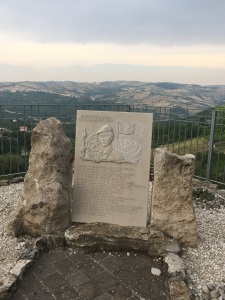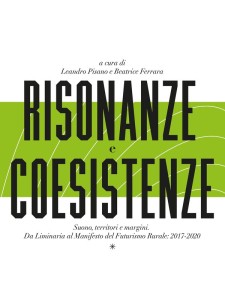Sonic Topographies of the South: Rural Futurity as Resonance and Dissonance
One of my earliest sonic memories is of the altar bells at Sunday Mass, which as a child I mistook for a literal manifestation of divine presence. And so, the discovery that this joyous sound was performed by those sneaky altar boys is one of my earliest disenchantments. Nonetheless, the notion that sound makes audible that which is otherwise imperceptible has stayed with me, as has some small hope of re-enchanting the world. Besides, the shared experience of listening to those bells still serves a socially unifying function, creating a commons that easily exceeds the religious.
This capacity that sound has for creating social spaces, for bringing us into relation with one another, remains one of my strongest impressions of Liminaria. “A fieldwork-based research project aimed at developing sustainable cultural, social and economic networks in the Fortore area” of Southern Italy, Liminaria is defined by its relation to place.[1] The Fortore river valley is a micro-region located at the intersection of Benevento, Campobasso, and Foggia, three provinces from three different regions. Far from the urban centers and tourist destinations of the coasts, Fortore offers a very different perspective into Italian life than one normally encounters. While resisting the Romantic clichés and binaries often associated with the concept of “rurality,” Liminaria’s curators nonetheless put the region’s “marginality” at the center of their curatorial mission. And though we can situate Liminaria within a tradition of avant-garde art practice based in the South of Italy, the project is unique in that the curators are themselves of the South, demonstrating a self-reflexivity that has often been missing from past engagements with Southern rurality.
In embracing both the contradictions and potentialities, “sounding out”[2] a space for the resonances and dissonances of Rural Futurism, Liminaria models an approach that is defined by collaboration and dialogue. The sonic spaces opened by Liminaria’s activities are eminently social, yet they also cultivate new means of thinking politically about realities which are otherwise difficult to perceive. This was made clear to me when I visited the Fortore region in June of 2017 during Philip Samartzis’ residency in San Marco dei Cavoti, in which he was making recordings of the region’s many wind turbines. Wind power, I was told, was a rapidly expanding enterprise in the area. Such infrastructure is much less dense on the Great Plains of America, with each windmill a mile apart from its neighbors. But Fortore’s hills and ridges are noticeably crowded with various models. While they are mostly silent unless one stands directly underneath them, the cluster of wind turbines presents as a kind of visual noise. This silent noise is a constant reminder of broken promises, of jobs and financial resources that have yet to benefit the area. But that visual noise is also a symbol of how even that which is most common—the very air—has been transformed into yet another resource to be extracted and exploited.
Samartzis’ activities facilitated the opportunity to have more meaningful conversations with local people about their relationship to the turbines. In the town hall of San Marco dei Cavoti, Samartzis delivered a short public lecture and performance, sharing rough versions of the recordings he’d made during his residency, making audible complex dynamics which would otherwise have gone unnoticed to outsiders. Samartzis brought the sounds of these silent monoliths into the heart of the community, their silence echoing the absence of delivered promises, their transformation into audibility allowing for this very discussion. Samartzis’ recording equipment enacts a process that finds a deeper parallel; the wind is transformed into energy, into power, transferred from rural to urban contexts.
We are often unaware of, or simply take as natural, the ways in which sound structures our lives. Sounds we hear every day often fade into the background of our consciousness, while traveling to unfamiliar places transforms what is mundane into something wondrous. While visiting Muslim countries for the first time, I was especially struck by the sound of the muezzins’ call to prayer, often audible from multiple nearby mosques at once. All those within earshot become members of an audible community, a kind of sphere emanating from each minaret. Even for non-believers, the experience of sound in space is powerful in that it is shared in a way that abstract clock-time is not.
Perhaps church bells play something of an analogous role, synchronizing the social comings and goings, breaking up the day. If in Italy the piazza remains a default place to gather publicly, the church bells extend this potential for gathering, the limits of audibility doubling as the border between inside and outside a given community. The audible range of every church bell is a temporary sonic microcosm of the ancient Roman Vestal Hearth which radiated as a bubble of heat from the earth, stretching to the Rubicon. [3]
As an Italian-American, I was raised in the Catholic church, and despite being a lapsed Catholic, it is perhaps unsurprising that my reflections upon my relationship to sound tends to return to religious examples. But in a majority Catholic country such as Italy, it would be difficult to overstate the importance of the Church’s role in structuring life, be it the layout of a village or the sounds which mark its borders. The force of Catholic tradition is especially strong in the South of Italy, even if it is a land of stereotypically superstitious faith and a syncretic tradition that still often evokes the magical.[4] Even in the cities, from Napoli to Catanzaro to Palermo, one finds endless edicole votive, death announcements, and shrines, one hears the sounds of old women chanting prayers, of mourning rituals, of church music.
The culture of cities has been influenced by waves of migration from rural territories, and the line between urban and rural, like that of north and south, is not drawn so easily.
“Oh! how difficult it is to remain calm and indifferent/While everyone around makes noise”[6]
Hearing this line, I can’t help but think about Napoli, the noisy city I’ve left behind on my short trip to the idyllic countryside. The topography of Fortore is far from the postcard views of the coast and the islands, offering neither touristic seaside nor agricultural plain. Many of my own sonic associations with the South of Italy are sounds of the coast: The gentle lull of the sea waves receding against the round stones. The din of birds and cicadas emanating from hills full of olive trees. The daily rhythms of the marina. But other sounds are less particular to the seaside: Footsteps reflected off the stone walls and paths of the dense villages. A motorino speeding down the sole road. The hum of some old engine putting uphill. The vigorous strikes and spins of a calcino match in the youth bar. Cards thrown down on the table by old men during a game of scopa. A meal being prepared in the kitchen, often heard drifting out through the windows above.
Reflecting upon the five editions of Liminaria from 2014 to 2018, shared themes emerge across very different projects: the relationship between people and the land, with nature, with technology, with animals, and with the concept of the future. Despite the remoteness from the coast, I recognize these categories within my own sonic associations. Their resonances form a sonic cartography of the South, revealing intersecting histories, relationships, and forms of life.
Read the entire piece in Risonanze e Coesistenze. Suono territori e margini, available for just € 0,99.
Other authors include Pietro Bonanno, Budhaditya Chattopadhyay, Nicola Di Croce, David Mollin & Salomé Voegelin, Alyssa Moxley, and many others, as well as multilingual translations of Leandro and Beatrice’s “Manifesto of Rural Futurism.”
 Footnotes
Footnotes
[1] Liminaria, “The Project,”
[2] Cf. Samuel R. Galloway and Joseph Sannicandro, “Queer Noise: Sounding the Body of Historical Trauma,” in Toward Gender Equality in the Music Industry: Education, Activism and Practice. Sarah Raine and Catherine Strong, Eds. (New York: Bloomsbury, 2019)
[3] Cf. Peter Sloterdijk, (1998) Bubbles: Spheres Volume I: Microspherology. Wieland Hoban, Trans. (Los Angeles, Semiotext(e), 2011)
[4] Cf. Ernesto de Martino, (1959) Sud e magia. (Milano: Feltrinello, 1982); Federico Campagna, Technic and Magic, (London: Bloomsbury, 2018)
[5] “White Flag”
[6] “Uh! com’è difficile restare calmi e indifferenti/ Mentre tutti intorno fanno rumore”
Source link
